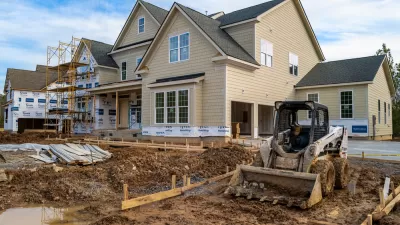Explore strategies for urban planners to manage and mitigate the impact of inflation on city development projects.

Rising costs in urban development are becoming a significant challenge due to inflation, global supply chain disruptions and increasing demand for raw materials. From skyrocketing fuel prices to rising labor expenses, these economic factors put immense pressure on budgets and timelines.
For urban planners, addressing these challenges safeguards the viability of projects that directly impact communities. Without proactive strategies, delays, budget overruns or cancellations can derail critical initiatives and leave cities struggling to meet growing demands. Understanding the root causes and taking strategic action keeps projects on track while ensuring long-term benefits.
The impact of rising costs on urban development
Inflation directly drives up material, labor and operational costs, creating significant challenges for development projects. As inflation stays high, typically above the federal target of 2 percent to 2.5 percent — reaching 3.5 percent to 3.8 percent in 2024 — workers demand more generous wage increases to keep up with rising living expenses. Employers, in turn, pass these higher labor costs on by raising prices for goods and services, such as construction materials and transportation.
These escalating liabilities can result in budget overruns and project delays or cancellations. When improvements stall, the long-term implications for communities are severe, including reduced economic growth and unmet housing demands. Urban planners must manage these cost pressures to deliver sustainable and impactful development.
Practical strategies to mitigate inflation effects
Inflation can significantly disrupt development projects, so planners must adopt proactive strategies to stay ahead. Here’s how urban planners can mitigate the effects of inflation and maintain momentum.
- Implement advanced cost forecasting: Use predictive modeling and market analysis to anticipate inflation trends and adjust budgets accordingly.
- Adopt phased development plans: Break large projects into minor, manageable phases to spread out costs and adapt to economic changes.
- Leverage value engineering: Focus on redesigns with cost-effective materials and methods that maintain quality while lowering expenses.
- Build public-private partnerships: Collaborate with private entities to share financial burdens and secure additional funding sources.
- Maximize technology: Virtual models like digital twins simulate infrastructure changes and predict their impact before implementation. Such tools can optimize designs, identify potential cost-saving measures and reduce risks.
- Focus on long-term sustainability: Prioritize energy-efficient designs and sustainable practices to reduce operational costs over time.
These strategies and innovative technologies can minimize the impact of inflation and ensure on-time, on-budget project completion.
Importance of continuous financial monitoring and adjustment
Regular budget reviews are fundamental to successful urban development. They help planners spot financial issues early and take corrective action before costs spiral out of control. These audits ensure projects stay on track toward their goals, maintaining momentum and delivering expected results. For governments, transparent budget monitoring also builds public trust by showcasing accountability and fiscal responsibility.
Planners can gain instant insights into spending patterns and cash flow with modern tools like real-time financial tracking software, cloud-based analytics, and AI-driven systems. These technologies streamline monitoring and enable data-driven decisions, ensuring initiatives stay financially sustainable and aligned with community expectations.
Exploring alternative funding sources
Urban planners have various funding alternatives to counter rising costs and keep projects moving forward. Federal and state grants ease financial burdens on municipalities while fostering stronger partnerships with higher levels of government.
Meanwhile, green bonds offer an innovative way to fund sustainable initiatives and attract eco-conscious investors. International aid programs can provide additional resources for large-scale infrastructure or recovery projects, particularly in underserved areas.
For smaller initiatives, community-driven crowdfunding has proven effective because it allows residents to support local outputs and strengthen community involvement. Additionally, tax incentives and credits attract private investors, offset costs and create mutually beneficial partnerships. These funding sources can secure the financial stability needed to bring transformative projects to life.
Building resilient urban projects through smart strategies
Strategic planning and financial agility are essential for urban planners to overcome rising costs and deliver successful projects. Embracing these approaches lets them ensure viability, adapt to economic challenges, and meet their communities’ needs.

Alabama: Trump Terminates Settlements for Black Communities Harmed By Raw Sewage
Trump deemed the landmark civil rights agreement “illegal DEI and environmental justice policy.”

Planetizen Federal Action Tracker
A weekly monitor of how Trump’s orders and actions are impacting planners and planning in America.

The 120 Year Old Tiny Home Villages That Sheltered San Francisco’s Earthquake Refugees
More than a century ago, San Francisco mobilized to house thousands of residents displaced by the 1906 earthquake. Could their strategy offer a model for the present?

LA’s Tree Emergency Goes Beyond Vandalism
After a vandal destroyed dozens of downtown LA trees, Mayor Karen Bass vowed to replace them. Days later, she slashed the city’s tree budget.

Sacramento Leads Nation With Bus-Mounted Bike Lane Enforcement Cameras
The city is the first to use its bus-mounted traffic enforcement system to cite drivers who park or drive in bike lanes.

Seattle Voters Approve Social Housing Referendum
Voters approved a corporate tax to fund the city’s housing authority despite an opposition campaign funded by Amazon and Microsoft.
Urban Design for Planners 1: Software Tools
This six-course series explores essential urban design concepts using open source software and equips planners with the tools they need to participate fully in the urban design process.
Planning for Universal Design
Learn the tools for implementing Universal Design in planning regulations.
Ada County Highway District
Clanton & Associates, Inc.
Jessamine County Fiscal Court
Institute for Housing and Urban Development Studies (IHS)
City of Grandview
Harvard GSD Executive Education
Toledo-Lucas County Plan Commissions
Salt Lake City
NYU Wagner Graduate School of Public Service






























